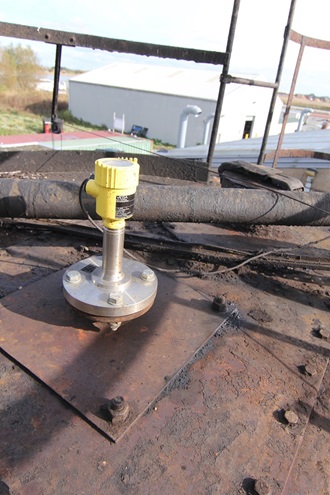A better focus on bitumen tank level
Bitumen is always a difficult product to measure, challenging with high temperatures, build up, splashing, sublimation and ready adhesion. Its handling safety parameters are also very high, with comprehensive safety guidelines from bitumen suppliers’ organisations and industry regulators. As part of this, effective, reliable level control for tanks is therefore of paramount importance.
Chase Protective Coatings, Rye
An 80 GHz radar is proving a worthy, proven solution for bitumen storage tank levels at Chase Protective Coatings at Rye, on the South coast of East Sussex. In the spring of 2016 they installed one of the first of a this new generation of radar level sensors in the UK. It has been in operation ever since, already providing a ‘long term’ testimony for what is still a relatively new technology. This application also provides a valuable insight to where the difference lies between various radar frequencies.
Chase make coated products for industrial use. For over 70 years they have made a material difference by developing high performance Industrial Coatings, tapes, adhesives and sealants that are marketed under brand names recognized as the most trusted in their respective industries for high reliability applications. Among the product lines produced at the Rye plant are cold applied bitumen tapes for light, medium and heavy duty pipe wrapping, along with other specialist tapes, moulding compounds, grids, marine tapes and PVC pipe wraps.
Bitumen Tank Level Application
Bitumen Tank Level Measurement Solution
VEGA supplied their latest 80 GHz technology radar sensor: VEGAPULS 64, on a sale or return basis. It was put forward for two main reasons; its performance with build up and its focusing. Build up on sensors when measuring bitumen is always a challenge to overcome, from splashing during filling and the sublimation of tar fumes from heating during storage. The high sensitivity electronics in this latest technology has the benefit that even heavy build up has minimal affect on sensor performance, and it has worked consistently without requiring cleaning. This long term reliability is just what users are looking for with this kind of product. Radar has an additional benefit, it measures liquid surface level/volume, so its accuracy is not influenced by changing product density either.
Focusing is another great advantage of this VEGAPULS 80 GHz radar, especially when compared to the 6GHz predecessor in this application. Its measuring beam is approximately 10 times better and sharper focused. So, if you compare 2 radars of each technology, both with a 3” antenna: 6GHz would be in the region of 30 degrees ...whereas the 80 GHz is just over 3 degrees! This improved focusing means that the radar signal path between the sensor and liquid surface does not see any interference from vessel walls, no false signals from rings of build up, or vessel internals. This focused capability results in non-contact radar devices that are easier and faster to set up, less likely to need tweaks, ‘remapping’ of false signals in vessels, delivering accuracy and reliability in the long term.
After its trial period ended in mid 2016, the device was purchased. The main benefit to the customer was being able to measure reliably and safely down to the vessel bottom, thus enabling smoother planning of production and effective scheduling of deliveries. Additionally, this device also has Bluetooth communications, which means at any time it can be remotely and safely accessed, to check level readings or diagnostics, without climbing the vessel or physically connecting to the sensor. The Engineering Manager for the site reported he was happy, commenting “We haven’t had a reading down at that level for years!”
Product:
Industry:
Export this article
Download as PDFShare this article
Comments ({{comments.length}})
{{getCommentAuthor(comment, "Anonymous")}} {{comment.timestamp | date : "dd.MM.yyyy HH:mm" }}
{{comment.comment}}


